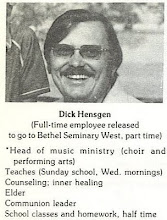
 This issue, Vol 1, number 12 of January 8, 1974 was posted on Facebook last week. I pointed out our salary structure for staff (an earlier post on this blog), but this article brought about a huge response. It brought out lots of memories about the whole issue of submission to elders and how this seemed to work out in the life of the church and the community. I promised to write a series of posts in five parts: 1) Our rationale, 2) Unintended consequences, 3) Unintended consequences seen in scores on the Taylor Johnson Temperament Analysis (TJTA), 4) Real abuse, and 5) My experience in this regard. This is the first posting dealing with our rationale. Having started this, I probably will have two posts on this.
This issue, Vol 1, number 12 of January 8, 1974 was posted on Facebook last week. I pointed out our salary structure for staff (an earlier post on this blog), but this article brought about a huge response. It brought out lots of memories about the whole issue of submission to elders and how this seemed to work out in the life of the church and the community. I promised to write a series of posts in five parts: 1) Our rationale, 2) Unintended consequences, 3) Unintended consequences seen in scores on the Taylor Johnson Temperament Analysis (TJTA), 4) Real abuse, and 5) My experience in this regard. This is the first posting dealing with our rationale. Having started this, I probably will have two posts on this.One of the key scriptures regarding elders and submission is Hebrews 13:7, "Remember your leaders who spoke the word of God to you. Consider the outcome of their way of life and imitate their faith. (NIV)" Of course, we understood the word "leaders" to be "elders". I am indebted to Time Pagaard for sending me a copy of "Covenant for First Baptist Church of Chula Vista; A Commentary and Exposition" by Ken Pagaard. One section of the covenant states, " . . . I gratefully submit to my leaders . . ." Ken's exposition follows, " . . . in our culture, submission is a bad word. The whole emphasis is on independence, on a freedom which is in fact licentiousness. As a result we see the disintegration of our society and degeneration of our civilization. The Bible on, on the other hand, puts a great stock in submission. It is a key to order and harmony. It is the key word in all of our human relationships. In fact, one of God's primary purposes for us is to develop within us a submissive spirit. As someone offers to disciple you, count it an honor and privilege. It means a real gift of himself. It is an awesome thing to accept responsibility for another. The Bible says that your leaders " are keeping watch over your souls, as men who will have to give account." (Heb. 13:17) . That is why it counsels us in the same verse "to obey your leaders and submit to them." This is not a submission that is servile and a bondage. In our context and the scriptural context it is a very freeing thing as the whole relationship is one of love, for the benefit of the disciple. To submit to this is to have a teachable spirit. That is why we can do it gratefully.
In the beginning of our eldership submission and authority had very little to do with it. Initially there were a few men, mainly Emery Fryer, Wallie Gray and Lehnis Lyons, who were functioning as pastoral helpers. As we had a large group of young people entering the church in the early 70's, Ken needed help in providing guidance and support to these new Christians. Many men desired to grow in their relationship and leadership within the congregation. We began to hold an open meeting on Wed. nights. There was probably a group of between 25 and 30 men who gathered for worship and prayer. These meetings would sometimes until 2 and 3 in the morning. They were great! Somewhere along the line, it was decided that this was a functioning eldership, although not necessarily all in the group were elders. This continued for several months.
Somewhere around 1973 there was a feeling that we needed to solidify this eldership; we needed to identify who were the elders. We put out a list to the congregation for their prayerful evaluation. Essentially, the congregation rated us on a 1-5 scale, 1 -- fully functioning as an elders and 5 -- not an elder at this time. I believe that an average of 3 would "qualify" one as an elder. As a side note, in 1981 I went through Ken's desk and found the original evaluations. I was the bottom one selected. I barely scraped in!
I will continue this posting tomorrow. It may take a couple of posts to deal with the rationale. Tomorrow, I will discuss how the leadership of the church was structured.

.jpg)
No comments:
Post a Comment